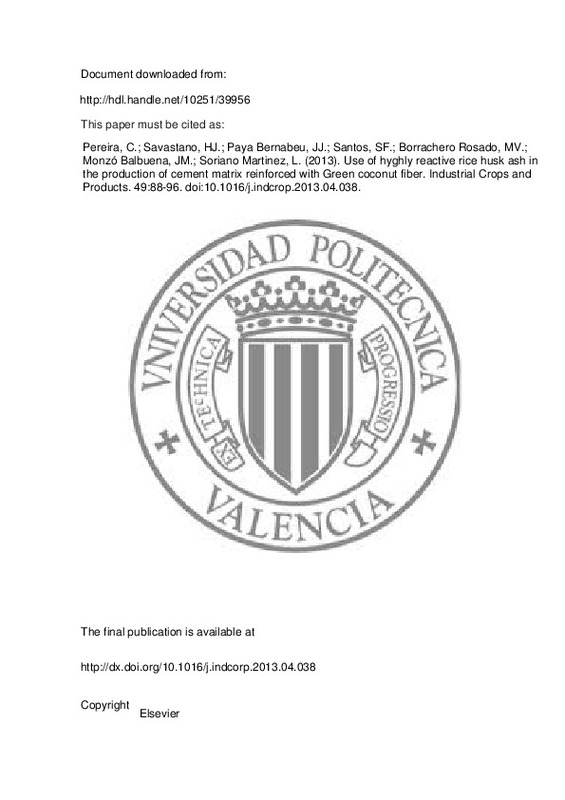JavaScript is disabled for your browser. Some features of this site may not work without it.
Buscar en RiuNet
Listar
Mi cuenta
Estadísticas
Ayuda RiuNet
Admin. UPV
Use of hyghly reactive rice husk ash in the production of cement matrix reinforced with Green coconut fiber
Mostrar el registro sencillo del ítem
Ficheros en el ítem
| dc.contributor.author | Pereira, C.L.
|
es_ES |
| dc.contributor.author | Savastano, H. Jr
|
es_ES |
| dc.contributor.author | Paya Bernabeu, Jorge Juan
|
es_ES |
| dc.contributor.author | Santos, S. F.
|
es_ES |
| dc.contributor.author | Borrachero Rosado, María Victoria
|
es_ES |
| dc.contributor.author | Monzó Balbuena, José Mª
|
es_ES |
| dc.contributor.author | Soriano Martínez, Lourdes
|
es_ES |
| dc.date.accessioned | 2014-09-24T10:08:07Z | |
| dc.date.available | 2014-09-24T10:08:07Z | |
| dc.date.issued | 2013-08 | |
| dc.identifier.issn | 0926-6690 | |
| dc.identifier.uri | http://hdl.handle.net/10251/39956 | |
| dc.description.abstract | [EN] This study evaluated the influence of partial replacement of Portland cement by rice husk ash (RHA) to enable the use of green coconut husk fiber as reinforcement for cementitious matrix. The use of highly reactive pozzolanic ash contributes for decreasing the alkaline attack on the vegetable fiber, originated from waste materials. The slurry dewatering technique was used for dispersion of the raw materials in aqueous solution, followed by vacuum drainage of water and pressing for the production of pad composites, as a simplified simulation of the Hatschek process for industrial manufacture. Five formulations were evaluated, two of them without any mineral additions. One of the mixtures served as a reference (without green coconut fibers) and the remaining ones were reinforced with the green coconut fibers (5% by weight of binder) and with the content of Portland cement replacement by RHA equal to 0, 30, 40 and 50%. The composites were analyzed at 28 days of age and after aging by immersion in warm wáter (65 ◦C), which lasted for 28 additional days. Physical and mechanical tests were applied for assessment of the performance of composites. Thermogravimetric analysis was used to observe the consumption of portlandite and chemically combined water content in the hydrated products for pastes presenting the same levels of Portland cement replacement by RHA (i.e., 0 50%) and with the water/binder ratio kept constant and equal to 0.5. The mechanical performance evaluated by bending test after 28 days reached the MOR of 15.7 MPa after the accelerate aging, for the composites reinforced with the green coconut fiber and with high levels of Portland cement replacement by RHA demonstrating that the use of Green coconut fiber for reinforcement can be very promising for the production of binary cement based matrix. The thermogravimetry showed that the replacement of Portland cement by the RHA helped in maintaining the mechanical behavior of the green coconut fiber in the composite subjected to the accelerated aging tests, and resulted in improved mechanical performance, providing a lightweight composite. | es_ES |
| dc.description.sponsorship | To the Fundacao de Amparo Pesquisa do Estado de Sao Paulo (FAPESP) for financial support and ICITECH Universitat Politecnica de Valencia for facilitating the research development. To the Federal Agency CNPq, Brazil for grants provided to the USP team. Project 3018/2009 financed by Generalitat Valenciana, COMBURES project financed by Centro de Cooperacion al Desarrollo de la Universitat Politecnica de Valencia (ADSIDEO COOPERACIO) and Maicerias Espanolas DACSA S.A. for supplying RHA samples. | |
| dc.language | Inglés | es_ES |
| dc.publisher | Elsevier | es_ES |
| dc.relation.ispartof | Industrial Crops and Products | es_ES |
| dc.rights | Reserva de todos los derechos | es_ES |
| dc.subject | Cement based composite | es_ES |
| dc.subject | Vegetable fiber | es_ES |
| dc.subject | Rice husk ash | es_ES |
| dc.subject | Cellulosic pulp | es_ES |
| dc.subject | Thermogravimetry | es_ES |
| dc.subject.classification | INGENIERIA DE LA CONSTRUCCION | es_ES |
| dc.title | Use of hyghly reactive rice husk ash in the production of cement matrix reinforced with Green coconut fiber | es_ES |
| dc.type | Artículo | es_ES |
| dc.identifier.doi | 10.1016/j.indcrop.2013.04.038 | |
| dc.relation.projectID | info:eu-repo/grantAgreement/GVA//GV%2F3018%2F2009/ | es_ES |
| dc.rights.accessRights | Abierto | es_ES |
| dc.contributor.affiliation | Universitat Politècnica de València. Departamento de Ingeniería de la Construcción y de Proyectos de Ingeniería Civil - Departament d'Enginyeria de la Construcció i de Projectes d'Enginyeria Civil | es_ES |
| dc.contributor.affiliation | Universitat Politècnica de València. Instituto de Ciencia y Tecnología del Hormigón - Institut de Ciència i Tecnologia del Formigó | es_ES |
| dc.description.bibliographicCitation | Pereira, C.; Savastano, HJ.; Paya Bernabeu, JJ.; Santos, SF.; Borrachero Rosado, MV.; Monzó Balbuena, JM.; Soriano Martínez, L. (2013). Use of hyghly reactive rice husk ash in the production of cement matrix reinforced with Green coconut fiber. Industrial Crops and Products. 49:88-96. https://doi.org/10.1016/j.indcrop.2013.04.038 | es_ES |
| dc.description.accrualMethod | S | es_ES |
| dc.relation.publisherversion | http://dx.doi.org/10.1016/j.indcorp.2013.04.038 | es_ES |
| dc.description.upvformatpinicio | 88 | es_ES |
| dc.description.upvformatpfin | 96 | es_ES |
| dc.type.version | info:eu-repo/semantics/publishedVersion | es_ES |
| dc.description.volume | 49 | es_ES |
| dc.relation.senia | 256266 | |
| dc.contributor.funder | Generalitat Valenciana | |
| dc.contributor.funder | Conselho Nacional de Desenvolvimento Científico e Tecnológico, Brasil | es_ES |







![[Cerrado]](/themes/UPV/images/candado.png)

